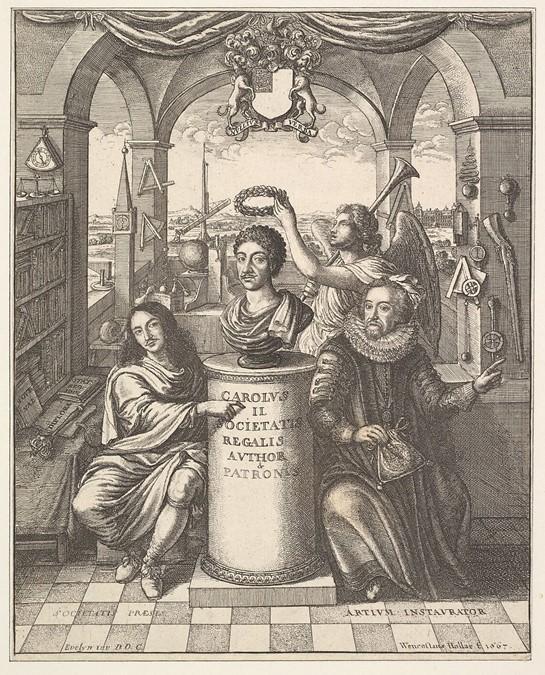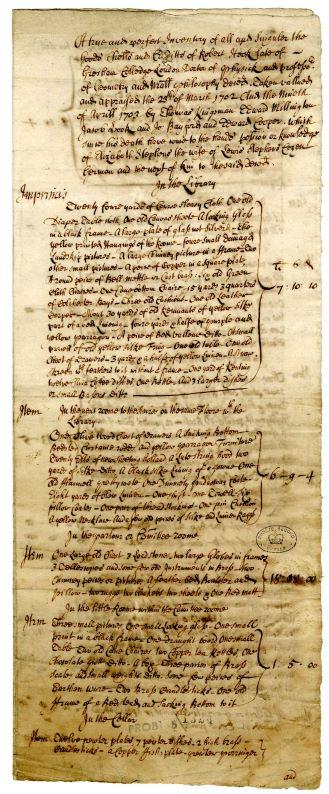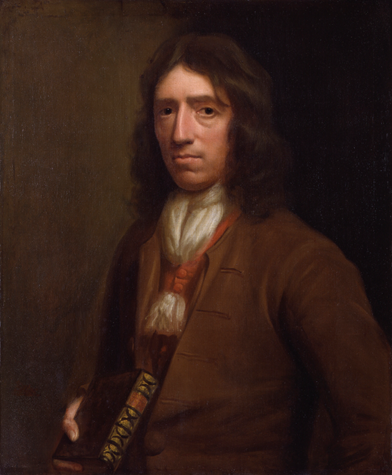Résumé
Founded in 1660, the Royal Society is the world’s oldest scientific institution. In the long eighteenth century, fellows dedicated themselves to understanding the causes of natural and artificial phenomena, but the activities that brought them together were also profoundly social and dictated by social convention. Like other London academies, the Royal Society conformed to eighteenth-century notions of sociability. In the spaces of Gresham College, and later Crane Court, a wide range of individuals came together to witness experiments and discourse on matters arising from external correspondence. These social activities were integral to the processes of experimental knowledge-making.
Mots-clés
On 28 November 1660, the first Royal Society meeting took place at Gresham College following an astronomy lecture by Christopher Wren. The meeting was attended by twelve people including some - Wren, John Wilkins, Robert Boyle and William Petty - who were part of a group of men that met in Oxford to discuss similar matters in the 1650s. Granted in 1662, the Royal Society’s first charter stated that the group were concerned with ‘matters philosophical, mathematical, and mechanical’ and that their work, through ‘the authority of experiment’, sought to advance both the ‘science of natural things’ as well as ‘useful arts.’1 The Royal Society was a voluntary organization described by John Evelyn as an ‘assembly of many honourable gentlemen’ and was funded by members’ dues.2 Despite its royal charter, financial assistance from the crown was minimal, especially in contrast to the Académie des Sciences in Paris where a smaller group of men applied themselves to the sciences and arts on state salaries. Historians do, however, consider the Royal Society a ‘corporate enterprise’, having a formal institutional structure, a motto and coat of arms, and the right to print and license books.3
- 1. Charter of The Royal Society, 1662.
- 2. John Evelyn to John Beale, 27 July 1670, quoted by Michael Hunter, Science and Society in Restoration England (Cambridge: Cambridge University Press, 1981), p. 44.
- 3. Michael Hunter, Science and Society in Restoration England, chapter two (he also refers to it as a ‘corporate experiment’, p. 38); Michael Hunter, Establishing the New Science: The Experience of the Early Royal Society (Woodbridge: The Boydell Press, 1989), chapter three; Noah Moxham, ‘Natural Knowledge, Inc.: the Royal Society as a metropolitan corporation’, The British Journal for the History of Science (vol. 52, n° 2, 2019), p. 249-271.
Meetings were the main social activity of the Royal Society. According to the Royal Society statues, these meetings were 'to order, take account, consider, and discourse on philosophical experiments and observations; to read, to hear, and discourse upon letters, reports and other papers containing philosophical matters.’4 As Curator of Experiment, Robert Hooke was expected to prepare three to four experiments for discussion at each meeting. In their first four decades, meetings took place most weeks, with an average of 37 per year, and lasted between one and two hours. However, fellows were sometimes accused of coming to meetings ‘only as to a play to amuse themselves for an hour or so’ (Hunter, Establishing the New Science, 204). A few years into their foundation, the Royal Society established the Philosophical Transactions, a scientific periodical overseen by the society’s secretary, which was published monthly and sold for a shilling. Natural history accounted for one-third of the articles published in the Philosophical Transactions in the mid eighteenth-century (1720-1779). Mixed mathematics, which includes astronomy, mechanics and geography, was the second most popular subject with approximately one-fifth of articles.5 Showing the mix of subjects the Royal Society were engaged in, there were also numerous articles on medicine, anatomy, experimental philosophy and antiquities.
Although not present in its charter, the Royal Society gently promoted a Baconian philosophy, which emphasised observation and collaboration in scientific inquiry. Amidst a plurality of worldviews, from Hermeticism to Cartesianism, Baconian philosophy was employed as a ‘unifying emblem’ that gave the appearance of homogeneity to activities and interests which were largely varied. This was a criticism of one contemporary who chastised the society for ‘so readily admitting all persons into their society, who will pay the duties of the house, though they know not the terms of philosophy.’6 What connected the somewhat disparate disciplinary backgrounds of fellows was a commitment to experience as a new standard of authority. As historian Peter Dear has argued, reporting an experience was a contribution to knowledge that represented a credential formerly supplied by reference to ancient texts; ‘located, explicitly or implicitly, at a precise point in space and time, the observer’s reported experience of a singular phenomenon constituted his authority.’7 The empirical emphasis of this epistemic shift has also prompted historians of science to highlight the influence of artisanal practice on the emerging empirical methodologies of the ‘New Science’.8 Indeed, the Royal Society’s early ‘history of trades’ programme sought to collect and codify information on craft practices and figures like Petty, and Boyle envisaged tradesmen and philosophers working together and learning from each other.
- 6. Angilae speculam morale (London, 1670), p. 45.
- 7. Peter Dear, ‘Totius in Verba: Rhetoric and Authority in the Early Royal Society’, Isis (vol. 76, n° 2, 1985), p. 159.
- 8. Pamela H. Smith, The Body of the Artisan: Art and Experience in the Scientific Revolution (Chicago: University of Chicago Press, 2004); Pamela Long, Artisan/Practitioners and the Rise of the New Sciences, 1400-1600 (Corvallis: Oregon State University Press, 2011).
The reality was quite different. In the History of the Royal Society (1667), an apologist history of the society, Thomas Sprat presented the Royal Society as an egalitarian institution ‘settled of many eminent men of all Qualities’.
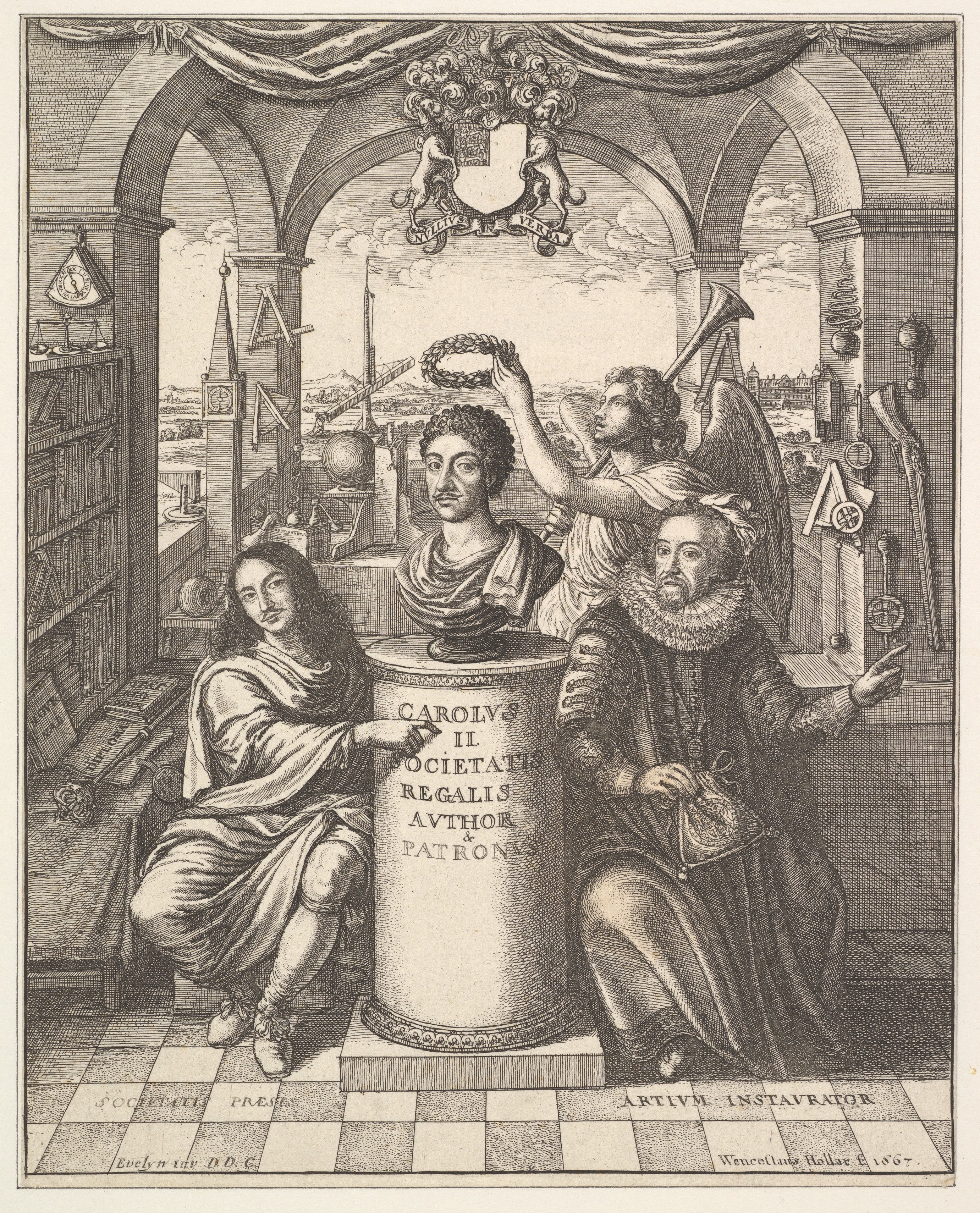
The engraving depicts the bust of Charles II surrounded by William Brouncker, the first president of the Royal Society, to the left, and Francis Bacon, ‘Artium Instaurator’ [founder of the arts], to the right.
He envisaged a society ‘not only by the Hands of learned and profiled Philosophers; but from the Shops of Mechanicks; from the Voyages of Merchants; [and] from the Ploughs of Husbandmen’ (Sprat 72). However, only 7% of the Fellows between 1660 and 1699 were merchants and tradesmen, and they were often, in the words of Michael Hunter, ‘exceptional in their class, having courtly connections, lodgings at Gresham College, or the like’ (Hunter, Science and Society, 7).9 Numbers for merchants/tradesmen in the mid-eighteenth century are not clear, but Richard Sorrenson calculates that for the period 1735-1780 the society was roughly composed of 20% aristocrats (up from 14% 1660-1699), 16% clerics and scholars, 16% physicians, 15% courtier and civil servants, and 15% gentlemen (Sorrenson 36). Election to the fellowship was a prestigious appointment and, as secretary, Henry Oldenburg frequently sent out printed lists of the fellows, as well as copies of the Philosophical Transactions, with his correspondence. William Musgrave, secretary of the Oxford Philosophical Society, confided how much of an honour it was to be ‘made of the same body with the most learned men of these times [and] with several of the nobility’ (Hunter, The Royal Society, 10). Although Margaret Cavendish, Duchess of Newcastle-upon-Tyne, was the first woman to visit the Royal Society in 166, she was not nominated or elected as a Fellow.
- 9. Also see Michael Hunter, The Royal Society and its fellows 1660-1700: the morphology of an early scientific institution (British Society for the History of Science, 1982).
Experiment was very much at the centre of the social and intellectual life of the Royal Society. Knowledge-making was a highly social process, for, in the words of Royal Society’s motto, matters were to be taken nullius in verba (on the word of no-one). Fellows at meetings would behave as participants in the making of experimental knowledge by acting as an ‘experimental public’ who needed to confirm empirical findings for them to be considered ‘matters of fact’. This was what Steven Shapin has called the ‘career of experimental knowledge’ which passed through three phases: the initial, private ‘trying’ of an experiment; the public ‘showing’ of an experiment and the public ‘discoursing’ upon the experiment.10 The public dimensions of this process, however, are largely contested, for the ‘showing’ and ‘discoursing’ of the experiment could operate between public and private spaces. Many experimental venues were private residences. Robert Boyle, for instance, resided in quarters in his sister, Lady Ranelagh’s house on Pall Mall, having his own laboratory. The laboratory was private in the sense that it was located in the basement of his residence and partly preserved the ideal of scholarly solitude, but it was also public for it was directly accessible from the street. This facilitated a flow of public visitors to Boyle’s laboratory, including many foreign visitors to London, it being ‘constantly opened to the curious’ (Shapin 70). Similarly, Hooke lodged permanently in Gresham College where the Royal Society met. Not only was he Curator of Experiments, but he was also the Cutlerian Professor of the History of Trades as well as Professor of Geometry at the college, living and working in the same space and even letting some rooms to the Society. Hooke died on 3rd March 1703 in Gresham College. There were a number of Royal Society books and administrative records in his possession, which were returned to the Royal Society when he died.
- 10. Steven Shapin, ‘The House of Experiment in Seventeenth-century England’, in Never Pure: Historical Studies of Science as If it was Produced by People with Bodies, Situated in Time, Space, Culture and Society, and Struggling for Credibility and Authority (Baltimore: Johns Hopkins University Press, 2010), p. 83.
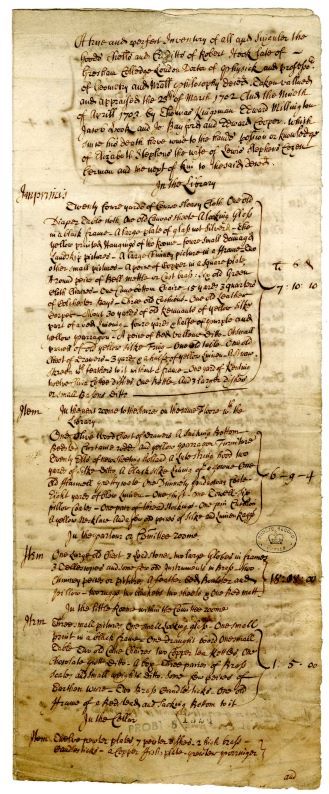
Not all claims to knowledge could be publicly demonstrated – for instance, observations of phenomena in foreign lands - and so the status of an individual was integral to evaluating the integrity of the knowledge claim. Steven Shapin’s influential work A Social History of Truth (1994) presents the Royal Society as a microcosm of genteel society; a culture of civility where birth, wealth, and virtue were connected in the moral economy of scientific knowledge. Given their independent wealth, gentlemen were regarded as particularly trustworthy because they harboured no material or self-interest and therefore no financial or other motive to misrepresent affairs. However, this interpretation has been challenged by a host of scholars such as Barbara Shapiro and Palmira Fontes da Costa, who have shown that the competence of the reporter and their expertise were as, if not more, important than gentility.11
- 11. Palmira Fontes da Costa, ‘The making of extraordinary facts: authentication of singularities of nature at the Royal Society of London in the first half of the eighteenth century,’ Studies in History and the Philosophy of Science 33 (2002), pp. 265-88; Barbara Shapiro, A Culture of Fact: England, 1550-1720 (Ithaca: Cornell University Press, 2003), p. 4. Also see, Philippa Hellawell, ‘ “The best and most practical philosophers”: Seamen and the authority of experience in early modern science’, History of Science (vol. 58, n° 1, 2020), p. 28-50.
Association with the Royal Society could do much to advance one’s reputation and there were attempts to elevate the status of a number of non-elite scientific informants for polite and learned society. William Dampier was a buccaneer brought to the attention of the Royal Society by the publication of A New Voyage round the World (thought to be edited by the physician and naturalist, Hans Sloane). Dampier clearly recognised the advantage of aligning his work with the Royal Society, dedicating A New Voyage round the World to the President and expressing his ‘ambition of transmitting [it] to the public through your hands.’12 Consequently, Dampier was welcomed into the fold, being invited to attend a meeting at Gresham College and having his book reviewed positively in the Philosophical Transactions. He dined with Samuel Pepys and John Evelyn, with the latter describing his work as ‘very extraordinary, & his observations very profitable.’13 Most notably, Sloane arranged for Dampier’s portrait to be painted by Thomas Murray, who had painted Sloane as well as King William and Queen Mary. In the portrait, Dampier was depicted modestly with his journal in hand, evoking an image of humble civility, as well as learning. His influence within the Royal Society was such that his brother, George Dampier, appealed for his assistance in introducing his paper on medicinal cures for rabies to the committee, which was eventually published in the Philosophical Transactions.14
- 12. William Dampier, A New Voyage Around the World (London: 1697), epistle dedicatory.
- 13. The Diary of John Evelyn, ed. E.S. de Beer, 6 vols. (Oxford: Clarendon Press, 1959), vol. 5, p. 295.
- 14. Royal Society, London, EL/D1/42; George Dampier and Hans Sloane, ‘Part of a letter from Mr George Dampier’, Philosophical Transactions (vol.20, 1698), p. 49-52.
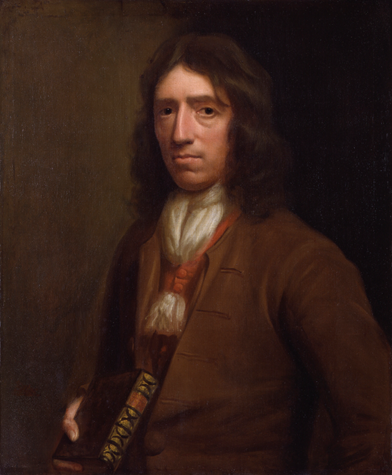
Public experiments were staged to verify, edify, and entertain. This could also be said for the circulation and exhibition of ‘curiosities’, which were simultaneously subjects of natural philosophical discourse, conversation pieces, and the foundation of an institutional repository.15 Subjects presented at meetings, and published in the Philosophical Transactions, included monstrous births, dwarfs and giants, intersex bodies, and some striking accounts of ‘a double kitten joined at the breast having one head and two bodies’, and ‘a monstrous lamb with a face, shoulders, arms to the elbows and whole trunk of a man.’16 As the Royal Society statutes specified, the purpose of the exhibition of these curiosities was ‘to discourse upon, rarities of nature and art; and thereupon to consider, what may be deduced from them, or any of them; and how far they, or any of them, may be improved for use or discovery’ (Sprat 145). This was a form of ‘learned entertainment’ that the Curator of Experiments, John Theophilus Desaguliers championed: 'a great many Persons get a considerable Knowledge of Natural Philosophy by Way of Amusement; and some are so well pleas'd with what they learn that Way, as to be induc'd to study Mathematics, by which they at last become eminent Philosophers.’17
- 15. London in 1710: from the Travels of Zacharias Von Uffenbach, trans. and ed. W. H. Quarrel and M. Mare (1934), pp. 98–99.
- 16. Palmira Fontes da Costa, ‘The making of extraordinary facts: authentication of singularities of nature at the Royal Society of London in the first half of the eighteenth century’, Studies in History and the Philosophy of Science (vol. 33, 2002), p. 266.
- 17. J. T Desaguliers, A Course of Experimental Philosophy, second edition (London: 1745), p. viii-ix.
Traditionally, historians have noted a decline in Royal Society activity in the eighteenth century: ‘the image is of a shift away from the esoteric mathematical natural philosophy and experimental philosophy identified with early ‘heroes’ such as Newton, Hooke and Boyle to an eclectic, undiscriminating concern with 'curiosities’, natural and artificial, perhaps in tune with the coffee-house culture.’18 However, while there were notable changes, there remained consistent, productive activity. Contrary to standard accounts, membership of the Royal Society increased from 131 in 1700 to 531 in 1800 and annual income expanded more than tenfold between 1700 and 1768 (Sorrenson 30). Experimental philosophy remained an important part of the Royal Society throughout the eighteenth century, despite assertions that it was practised less and less. For each decade between the 1720s and 1770s, around 10% of papers in the Philosophical Transactions were on subject related to experimental natural philosophy, which is consistent with broader figures suggesting that 10% of papers, from a sample between 1665 and1800, all concern experiments (Sorrenson 39).
- 18. David P. Miller, ‘“Into the valley of darkness”: reflections on the Royal Society in the eighteenth century’, History of science (vol. 27, n° 2, 1989), p. 157.
Promoting the public good became an essential component of the rhetoric of the early Royal Society, especially when faced with the common question from critics, ‘What have they done?’, and satirical commentary from plays like Thomas Shadwell’s The Virtuoso (1676).19 Such an atmosphere had arguably led to the composition of Sprat’s apologetic history of the society just seven years into its existence, where he highlighted the ‘want of use, fear of practice, and a conversing of things within their study’ as the ‘last failing’ of the ‘learned man’ (Sprat 338). From the outset, the Royal Society was keen to emphasise the usefulness of natural knowledge, demonstrating how it could advance the human condition and enrich society ‘with all the Benefits of Fruitfulness and Plenty’ (Sprat 438). This explains the emphasis on ‘useful arts’ in the charter and the preponderance of mixed mathematics in the Philosophical Transactions. David Philip Miller has shown that the ideology of utility and improvement actually remained a ‘powerful force’ within the Royal Society until the later eighteenth century.20 There was considerable overlap between personnel in the Royal Society and the Society of Engineers and the Lunar Society, while the society’s Curators of Experiments, Desaguliers and Francis Hauksbee, also gave public lectures across London’s coffeehouses and inns in the early eighteenth century. As the eighteenth century progressed, there was deeper involvement between the Royal Society and the structures of the state with the President serving on the Board of Longitude and members Royal Society serving as the Board of Visitors’, which oversaw the running of the Royal Observatory.
- 19. This is a question Joseph Glaville responds to in chapter XII of Plus Ultra, or the progress and advancement of knowledge (London: 1668); Thomas Shadwell, The Virtuoso (London: 1676). On science and satire in eighteenth century England, see Gregory Lynall, Swift and Science: The Satire, Politics, and Theology of Natural Philosophy, 1690-1730 (Basingstoke: Palgrave Macmillan, 2012).
- 20. David Philip Miller, ‘The usefulness of natural philosophy’: The Royal Society and the culture of practical utility in the later eighteenth century’, British Journal for the History of Science (vol. 32, n° 2, 1999), p. 185-201.
Throughout the long eighteenth century, what tied the Royal Society’s fellows and activities together was a vast web of correspondence. Their charter had given them ‘licence to hold a literary correspondence on philosophical, mathematical, and mechanical subjects with all sorts of foreigners.’21 As the Royal Society’s first secretary, Oldenburg initially engineered and oversaw correspondence across Britain, continental Europe, and the Americas, where he also solicited observations and publications for Philosophical Transactions and maintained the membership through the collection of dues. Indeed, when he died, there was a dip in the number of fellows and consequently finances. A few years after his death, John Flamsteed reported that ‘our Meetings at the Royall Society want Mr Oldenburg’s correspondencys and on that account are not so well furnished nor frequented as formerly’.22 However, as Alice Marples has shown, the Royal Society managed to acquire a more stable financial footing under the secretaryship of Hans Sloane (1693–1713) and the presidency of Newton (1703–27) through a range of investments and repeated attempts to recoup arrears.23 Sloane, and some his successors, also brought their own vast correspondence networks to role of secretary, enabling the Royal Society to maintain their epistolary connections throughout the world.
- 21. Charter of The Royal Society, 1662.
- 22. John Flamsteed to Richard Towneley, 13 Feb. 1680, quoted in Hunter, Establishing the New Science, p. 255.
- 23. Alice Marples, ‘Scientific administration in the early eighteenth century: reinterpreting the Royal Society's Repository', Historical Research (vol. 92, n° 255, 2019), p. 183-204.
Partager
Références complémentaires
Moxham, Noah, ‘Natural Knowledge, Inc.: the Royal Society as a metropolitan corporation’, The British Journal for the History of Science (vol. 52, n° 2, 2019), p. 249-271.
Shapin, Steven and Simon Schaffer, Leviathan and the Air-Pump: Hobbes, Boyle and the Experimental Life (Princeton, NJ: Princeton. University Press, 2018).
Shapin, Steven, A Social History of Truth: Civility and Science in Seventeenth-Century England (Chicago: University of Chicago Press, 1995).
